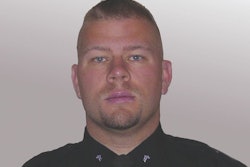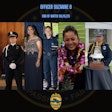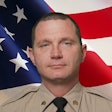There is probably no more misunderstood law enforcement duty than traffic enforcement. Cops who perform this duty often think of it as tedious and futile. And the motorists who are pulled over for traffic violations feel like they are being picked on and tapped for fines that fill local government coffers.
Yet, even though the men and women who perform traffic code enforcement get little respect either in or out of the police community, their work is critical to public safety. Speeders, reckless drivers, and most of all drunk drivers kill more Americans each year than murderers. So no matter how tedious it can become, traffic enforcement should never be taken lightly by officers. It saves lives.
And sometimes it even catches killers.
Cops in the know have sometimes referred to their vehicle code manuals as "probable cause bibles." And with good reason. After all, a traffic stop can open the doors to a legal search of a vehicle for illegal substances, stolen goods, and even dead bodies.
What follows are some examples of how alert traffic officers have helped end the careers of some of America's most prolific murderers.
Case #1: Randy Kraft
Violation: Possible Drunk Driving
On May 14, 1983, officers of the California Highway Patrol noticed that a Jeep driven by Randy Kraft was weaving in its lane on Interstate 5. They pulled Kraft over near the south Orange County suburb of Mission Viejo. Kraft got out of his car and walked to the officers.
There on the side of the freeway, the CHP officers had Kraft submit to a field sobriety test. The computer programmer and former Marine failed the test.
Kraft was taken into custody and secured in the back of a CHP patrol car. The "chippies" then conducted a search of his Jeep.
And they found a lot more than a few empty beer bottles or an open fifth of Jack. On the front passenger seat of Kraft's Jeep was the shrouded body of a young Marine, Terry Gambrel.
Subsequent investigation revealed that Gambrel had been heavily sedated and then strangled with a ligature. It was later learned that Kraft was the "Southern California Strangler," a prolific murderer who picked up young men-primarily Marines-drugged them, tortured them, strangled them, and pushed their bodies out of his car as he sped south on the freeway.
Kraft was convicted of 16 murders. But authorities believe he may have been responsible for more than 67. He awaits execution on California's Death Row.
Case #2: William Lester Suff
Violations: Illegal U-Turn/ Expired Registration
On Jan. 9, 1992, an officer of the Riverside (Calif.) Police Department spotted a 1989 Mitsubishi van making an illegal U-turn. As the officer closed on the vehicle, he also noticed that its registration was expired. He effected a traffic stop and soon discovered that the van's driver, William Lester Suff, was operating his vehicle on a suspended license and that he was the owner of many unpaid traffic tickets.
Suff was detained on the traffic violations. Which was really bad luck for him because a check of his van's plates spurred interest from investigators who were working the murders of numerous prostitutes in the Riverside area. Suff's van was the same one that had been seen at the dump sites where the murder victims' bodies were found.
Further investigation resulted in an indictment of Suff on 12 counts of murder spanning seven years. Suff was convicted of rape, murder, and mutilation in 1995. He is on California's Death Row.
Case #3: Theodore "Ted" Bundy
Violation: Too Many to List
Ted Bundy is one of the most infamous serial killers in American criminal history. From 1966 to the late '70s, he murdered more than two dozen young women and teenage girls in Washington, Utah, Colorado, and Florida. Bundy was also one of the world's worst drivers, and a number of alert cops pulled him over for numerous traffic violations throughout his life.
On August 16, 1975, Bundy was driving a light-colored Volkswagen near Salt Lake City with his lights off. This caught the attention of Utah Highway Patrol Officer Bob Haywood, who lit up Bundy's car. A chase ensued. Bundy was arrested for evasion of police and released on his own recognizance. A subsequent investigation resulted in Bundy being convicted of aggravated kidnapping. He was sentenced to one to 15 years and extradited to Colorado to stand trial for murder.
Bundy escaped custody on June 7, 1977, but once again his driving skills piqued the interest of a traffic officer. He was arrested on June 13 in Aspen for driving erratically in a stolen car.
But holding on to Ted Bundy was not easy. He escaped again on Dec. 30, 1977. And this time, he didn't hang around Colorado. Instead, he got out of the state, bounced around a few different locations, and came to rest in Tallahassee, Fla.
In Florida, Bundy resumed his hobby of terrorizing and murdering young women, particularly students at Florida State University. And once again, Bundy's driving garnered the attention of an alert officer. But while the officer ran Bundy's plates, the killer escaped, returned to his apartment, wiped it clean, and stole yet another Volkswagen.
Bundy fled to nearby Pensacola. There, a patrol officer spotted Bundy's VW, ran its plates, and learned that the vehicle was stolen. Bundy was arrested, and this time he didn't escape. He was tried and convicted for several murders of Florida State coeds. He sat down in "Old Sparky" on Jan. 24, 1989, and he didn't stand back up.[PAGEBREAK]
Case #4: David Berkowitz
Violation: Parking Next to a Fire Hydrant
New York City's ".44 Caliber Killer," David Berkowitz, terrorized the city during the Carter years until he was arrested in 1977. Berkowitz, who called himself the "Son of Sam," killed six young men and women and wounded nine others during his bloody career.
The Son of Sam's MO was to walk up on couples sitting in parked cars and open fire on them with his .44 caliber Charter Arms revolver. Ironically, it was a parking violation that helped put him away.
On July 31, 1977, Berkowitz attacked Stacy Moskowitz and Bobby Violante who were parking at Gravesend Bay in Brooklyn, killing Moskowitz. Berkowitz was already a person of interest in the investigation, but the first solid evidence that police gathered against him was a parking ticket that was written in the Gravesend Bay area the night of the Moskowitz murder.
Berkowitz's home was put under surveillance, and officers of the Yonkers Police Department arrested him. Under interrogation, Berkowitz admitted to being the Son of Sam. He was convicted and sentenced to 364 years in prison. Berkowitz now lives in Attica State Prison, where he converted to Christianity and now refers to himself as the "Son of Hope."
Case #5: Joel Rifkin
Violation: No License Plate
If former gardener and prolific murderer Joel Rifkin were to give a lecture to aspiring serial killers, he would probably lead off with the following advice: "Put a license plate on your vehicle."
At 3:15 a.m. on June 28, 1993, New York state troopers Sean Ruane and Deborah Spaargaren spotted a Mazda pickup with no plate cruising on Long Island's Southern State Parkway. They turned on their flashers, and the driver sped away. A high-speed chase ensued, involving multiple officers and ending with the Mazda crashing into a telephone pole.
If you had been Rifkin, you would have run, too. Not only did his pickup have no plate, there was a decomposing body of a woman inside the bed.
A subsequent search of the home that Rifkin shared with his mother and sister led to even more grisly evidence of his deeds, including a chainsaw and human blood found in the garage. Rifkin was convicted on May 9, 1994. He was sentenced to 183 years on seven counts of murder, with 10 counts outstanding. His current home is the N.Y. State Correctional Facility in Clinton. And wouldn't it be great irony if he spends his days making license plates?
Case #6: Timothy McVeigh
Violation: No License Plate
Next to Osama Bin Laden, Pendleton, N.Y.-born Timothy James McVeigh is the greatest terrorist enemy the people of America have ever known. The truck bomb that McVeigh parked in front of the Alfred P. Murrah Federal Building in Oklahoma City on April 19, 1995, killed 168 people and maimed hundreds more.
In some ways the Gulf War veteran was a mastermind. In others, he was a moron. Investigators caught McVeigh through good old-fashioned detective work by the FBI and because he was too stupid to put a license plate on his getaway car.
We can thank Charles Hanger, an Oklahoma Highway Patrol officer, for making this collar. The day of the bombing he spotted McVeigh's Mercury Marquis cruising down I-35 near Pawnee, Okla., without a plate. Hanger made a traffic stop, used probable cause to search the vehicle, and found a loaded firearm. McVeigh was arrested and, three days later, the FBI came to get him.
On June 2, 1997, a federal jury convicted McVeigh of killing eight federal employees who were victims of the Oklahoma City bombing. Eleven days later, the same jury voted that he was a waste of human life.
McVeigh was executed by lethal injection on June 11, 2001, at the U.S. Federal Penitentiary in Terre Haute, Ind. His co-conspirator Terry Nichols got life. Other accomplices are suspected by some authorities.[PAGEBREAK]
Case #7: Wayne Williams
Violation: Stopping on a Bridge
The Atlanta Child Murders are some of the most controversial criminal cases of the last 50 years. In 1979 and 1980, as many as 30 young African Americans-primarily children and teenagers-were killed by a serial murderer or murderers in the Atlanta area.
Atlanta's African-American community was convinced that the slayings were the work of white men, presumably members of the Ku Klux Klan or another hate group. Detectives working the case found that theory less than credible. Investigators caught a break in April 1981 when the bodies of Jimmy Payne, 21, and William Barrett, 17, were pulled from the Chattahoochee River. They decided to watch the bridges and see who was dropping bodies.
Before dawn on the morning of May 22, 1981, a rookie officer positioned below a bridge heard an object fall into the water. Above him two other officers stopped a vehicle driven by Wayne Bertram Williams and cited him for stopping on a bridge. They searched his car and found nothing. Two days later, the body of Nathaniel Carter, 27, was pulled out of the river downstream from the bridge.
Wayne Williams was arrested on June 21 and charged with Carter's murder. On July 17, he was indicted for the murders of Carter and Payne. Forensic evidence was used to make the case, and Williams was convicted on Feb. 27, 1982. He was sentenced to life in prison.
Many people, including some officers, believe that the majority of the Atlanta Child Murders remain unsolved. Others say that Williams is the killer. The debate rages to this day.
Case #8: Bruce A. Davis
Violation: Tampering with a Vehicle
There are several things that can be learned by studying the case of Bruce A. Davis, a homicidal drifter who confessed to dozens of murders that occurred from 1969 to 1971.
Number 1: Traumatic events can lead to later violent behavior. Davis claimed that he was raped by a gay man when he was 13. He spent much of his adult life preying on homosexuals.
Number 2: Never turn your back on a convicted killer. While serving time for a Chicago-area murder, Davis was transferred to the Illinois State Prison in Menard in 1982. There, on Oct. 24, he somehow got his hands on an axe and attacked his guard. The guard was mortally wounded and Davis escaped.
Number 3: Somebody breaking into a car could be a serial killer on the run. Seven days after his escape from Menard-on Halloween night-Davis came to the attention of deputies from the Fayette County (W.Va.) Sheriff's Department. He was apprehended after trying to break into a car in the town of Smithers.
Davis received a life sentence for killing his guard during the escape from Menard. So, he figured he didn't have anything to lose. His confessions closed 32 murders in cities coast to coast and in San Juan, Puerto Rico.
Case #9: Larry Eyler
Violation: Parking on a Highway
Like many other serial killers throughout history, Larry Eyler was a conflicted homosexual who preyed on gay men.
Eyler's first known victim was Jay Reynolds, found stabbed to death on the outskirts of Lexington, Ky., on March 22, 1982. He then went on a murder spree that resulted in the deaths of 20 men and boys. All of their bodies were dumped on the sides of roads in Kentucky, Indiana, and Illinois-a practice that led to the press dubbing Eyler "The Interstate Killer."
Eyler's last intended victim owes his life to an Indiana Highway Patrol Officer who noticed a pickup truck parked along I-65 and saw two men moving toward the tree line. The sharp-eyed officer quickly realized that one of the men was tied up. The officer investigated and discovered that Eyler had picked up the other man for sex and then tied him up. A subsequent search of Eyler's truck yielded a blood-stained hunting knife. Eyler was taken into custody and later released.
But he was now the investigators' prime person of interest. Forensic evidence, including tire tracks and boot imprints, linked Eyler with the murder of Ralph Calise who had been found in a field near Lake Forest, Ill. The blood on the knife matched Calise, who had been stabbed 17 times. Unfortunately, a pre-trial hearing suppressed the evidence found in the truck. And the other forensic evidence was ruled fruit of the poisonous tree.
Eyler was freed and he continued killing. But he got really sloppy, dismembering and bagging the body of a 15-year-old gay hustler before dumping it in his own garbage. A janitor's dog uncovered that horror, and the Chicago police arrested Eyler for murder.
The Interstate Killer was convicted on July 9, 1986. He was sentenced to death by lethal injection, but he died of AIDS in 1994.
Case #10: James E. Swann Jr.
Violation: Running Red Lights
For two months in 1993 the residents of the Columbia Heights and Mount Pleasant neighborhoods of Washington, D.C., lived in fear of the "Shotgun Stalker," a man who drove around the area blasting pedestrians with a shotgun.
Then on April 19, Metropolitan Police Officer Kenneth Stewart saw a car run through a couple of red lights. Stewart, who was reportedly off duty at the time, gave chase and captured James E. Swann Jr. Inside Swann's car, police found a recently fired shotgun.
Swann was arrested and indicted on four counts of murder and 10 counts of attempted murder. He pleaded not guilty by reason of insanity. Court testimony revealed that Swann was severely schizophrenic, hearing voices that told him to attack his victims. Swann currently resides in a Washington area mental hospital.
Dean Scoville is a patrol supervisor with the Los Angeles County Sheriff's Department and a contributing editor to Police.














